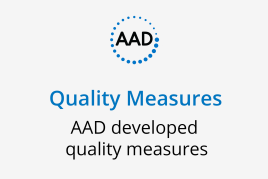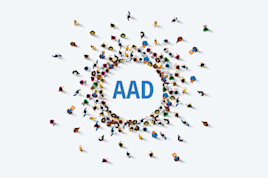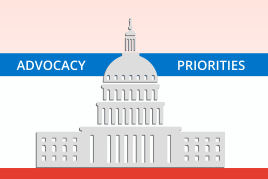Skin conditions by the numbers
Acne
Acne is the most common skin condition in the United States, affecting up to 50 million Americans annually. (1)
There are different types of acne (blackheads, whiteheads, pimples, acne cysts or nodules), so a one-size-fits-all approach is not the best way to achieve clearer skin. (2) A board-certified dermatologist can diagnose the type of acne you have and determine the right treatment based on your skin type and type of acne.
There are many effective acne treatments available from oral to topical over-the-counter or prescription medications or products. (2)
Acne usually begins in puberty and affects many adolescents and young adults; however, it can occur at any stage of life and may continue into one’s 30s and 40s. (3-5) Adult acne continues to increase and affects up to 15% of women. (3-6)
Approximately 85% of people between the ages of 12 and 24 experience at least minor acne. (7)
Eczema
Eczema refers to a group of conditions that lead to inflamed skin. Signs of inflamed skin include a rash, itchiness, and excessive dryness. (8)
There are several types of eczema. Atopic dermatitis is the most common type.
Eczema is a complex condition. Your genes, immune system, and what touches your skin may play a role in eczema. (8) A board-certified dermatologist can determine what’s affecting your eczema and recommend an appropriate treatment.
While there is no cure for atopic dermatitis, most cases can be controlled with proper treatment. The goals of treatment are to keep the skin moist, reduce inflammation and the risk of infection, and minimize the itch associated with the rash. (9-11)
Atopic dermatitis affects nearly 1 in 10 Americans of all ages. (12)
It affects up to 1 in 5 children under the age of 18. (12)
Hair loss
Many conditions and diseases can result in hair loss, as can improper hair care.
The most common cause of hair loss is hereditary thinning or baldness, also known as androgenetic alopecia. (13) This condition affects an estimated 80 million Americans — 50 million men and 30 million women. (14)
While daily shedding is normal, people who notice their hair becoming noticeably thinner or falling out in large amounts should consult a board-certified dermatologist for proper diagnosis and treatment.
Potential causes of hair loss, some of which are temporary, include:
Alopecia areata, a type of autoimmune hair loss that can affect all ages and causes hair to fall out in round patches. (15,16)
Genetic factors.
Tight hairstyles that pull on the hair. (17-19)
Shampooing, combing, or brushing hair too much or too hard. (17)
Hair plucking, which may be a sign of a disorder called trichotillomania. (17)
A variety of diseases, including thyroid disease and lupus. (17,20)
Childbirth, major surgery, high fever or severe infection, stress, or even the flu. (17)
If you need treatment for regrowth, the earlier you start, the more likely you are to see regrowth.
Psoriasis
Psoriasis is a chronic inflammatory disease of the immune system that develops when the body makes skin cells too quickly, causing skin cells to pile up and form visible patches or spots on the skin. (21-26)
Psoriasis and psoriatic arthritis can be associated with other diseases and conditions, including diabetes, cardiovascular disease, inflammatory bowel disease, and depression, so it’s important to see a board-certified dermatologist if you have symptoms of psoriasis or psoriatic arthritis. (24,27-31)
Healthy lifestyle choices that can help reduce psoriasis flares include eating a balanced diet, regular exercise, managing stress, getting an adequate amount of sleep, staying hydrated, moisturizing your skin, not smoking, and avoiding triggers.
Psoriasis occurs in people of all ages but is primarily seen in adults, with the highest proportion between ages 45 and 64. (32)
Psoriasis affects nearly 7.5 million people in the United States. (27,33)
Topical treatments are helpful for mild to moderate psoriasis but do not tend to be effective for treating moderate to severe psoriasis. (23,24)
Psoriasis patients with moderate to severe psoriasis can be treated with traditional systemic medications, which work throughout the body; biologic medications, which also work throughout the body, targeting specific parts of your immune system; or phototherapy, which utilizes UV light. (21,22,25-27,34,35)
In cases of more extensive psoriasis, topical agents may be used in combination with phototherapy, or traditional systemic or biologic medications. (21-23,25-27,34,35)
Rosacea
Rosacea is a common skin condition that mainly affects the face. You may see flushing, lasting color (red, violet, or brown), acne-like breakouts, or visible blood vessels. Some people develop irritated eyes or thickening skin. (36,37)
Although there is no cure for rosacea, proper treatment can help control the condition.
While people of all ages and races can develop rosacea, it is most common in the following groups:
People between ages 30 and 60. (38-40)
Individuals with fair skin, blond hair and blue eyes. (38,40,41)
Women, especially during menopause. (38)
Those with a family history of rosacea. (40)
Exactly what causes rosacea is unclear. However, scientific breakthroughs, many made by dermatologists, are giving us a better understanding of what may be happening inside the body. It’s possible that the many signs and symptoms of rosacea are due to inflammation. As the inflammation increases, so do the signs and symptoms.
Rosacea treatment may include topical or oral antibiotics, other topical medications including redness-reducing creams, or laser procedures.
Thickened skin may be treated with lasers, dermabrasion or electrocautery.
Redness or broken blood vessels from rosacea can also be treated with lasers.
See more skin conditions by the numbers:
Related AAD resources
Want to know what dermatologists tell their patients about managing conditions that affect the skin, hair, or nails? You’ll find their expertise and insight in Diseases and conditions.
References
Bickers DR, Lim HW, Margolis D, et al. The burden of skin diseases: 2004 a joint project of the American Academy of Dermatology Association and the Society for Investigative Dermatology. J Am Acad Dermatol. Sep 2006;55(3):490-500. doi:10.1016/j.jaad.2006.05.048
Reynolds RV, Yeung H, Cheng CE, et al. Guidelines of care for the management of acne vulgaris. J Am Acad Dermatol. May 2024;90(5):1006 e1-1006 e30. doi:10.1016/j.jaad.2023.12.017
Holzmann R, Shakery K. Postadolescent acne in females. Skin Pharmacol Physiol. 2014;27 Suppl 1(Suppl. 1):3-8. doi:10.1159/000354887
Khunger N, Kumar C. A clinico-epidemiological study of adult acne: is it different from adolescent acne? Indian J Dermatol Venereol Leprol. May-Jun 2012;78(3):335-41. doi:10.4103/0378-6323.95450
Tanghetti EA, Kawata AK, Daniels SR, Yeomans K, Burk CT, Callender VD. Understanding the burden of adult female acne. J Clin Aesthet Dermatol. Feb 2014;7(2):22-30.
Collier CN, Harper JC, Cafardi JA, et al. The prevalence of acne in adults 20 years and older. J Am Acad Dermatol. Jan 2008;58(1):56-9. doi:10.1016/j.jaad.2007.06.045
Bhate K, Williams HC. Epidemiology of acne vulgaris. Br J Dermatol. Mar 2013;168(3):474-85. doi:10.1111/bjd.12149
Sohn A, Frankel A, Patel RV, Goldenberg G. Eczema. Mt Sinai J Med. Sep-Oct 2011;78(5):730-9. doi:10.1002/msj.20289
Sidbury R, Alikhan A, Bercovitch L, et al. Guidelines of care for the management of atopic dermatitis in adults with topical therapies. J Am Acad Dermatol. Jul 2023;89(1):e1-e20. doi:10.1016/j.jaad.2022.12.029
Davis DMR, Drucker AM, Alikhan A, et al. Guidelines of care for the management of atopic dermatitis in adults with phototherapy and systemic therapies. J Am Acad Dermatol. Feb 2024;90(2):e43-e56. doi:10.1016/j.jaad.2023.08.102
Davis DMR, Drucker AM, Alikhan A, et al. American Academy of Dermatology Guidelines: Awareness of comorbidities associated with atopic dermatitis in adults. J Am Acad Dermatol. Jun 2022;86(6):1335-1336 e18. doi:10.1016/j.jaad.2022.01.009
Abuabara K, Magyari A, McCulloch CE, Linos E, Margolis DJ, Langan SM. Prevalence of Atopic Eczema Among Patients Seen in Primary Care: Data From The Health Improvement Network. Ann Intern Med. Mar 5 2019;170(5):354-356. doi:10.7326/M18-2246
Rossi A, Anzalone A, Fortuna MC, et al. Multi-therapies in androgenetic alopecia: review and clinical experiences. Dermatol Ther. Nov 2016;29(6):424-432. doi:10.1111/dth.12390
Androgenetic alopecia. National Library of Medicine. Updated 7/27/2023. Accessed 10/31/2024, https://medlineplus.gov/genetics/condition/androgenetic-alopecia/#statistics
Dainichi T, Kabashima K. Alopecia areata: What's new in epidemiology, pathogenesis, diagnosis, and therapeutic options? J Dermatol Sci. Apr 2017;86(1):3-12. doi:10.1016/j.jdermsci.2016.10.004
Rajabi F, Drake LA, Senna MM, Rezaei N. Alopecia areata: a review of disease pathogenesis. Br J Dermatol. Nov 2018;179(5):1033-1048. doi:10.1111/bjd.16808
Fabbrocini G, Cantelli M, Masara A, Annunziata MC, Marasca C, Cacciapuoti S. Female pattern hair loss: A clinical, pathophysiologic, and therapeutic review. Int J Womens Dermatol. Dec 2018;4(4):203-211. doi:10.1016/j.ijwd.2018.05.001
Phillips TG, Slomiany WP, Allison R. Hair Loss: Common Causes and Treatment. Am Fam Physician. Sep 15 2017;96(6):371-378.
Geisler AN, Oyerinde O, Scott DA. Hairstyling Practices to Prevent Hair Damage and Alopecia in Women of African Descent. Cutis. Feb 2022;109(2):98-100. doi:10.12788/cutis.0444
Wolff H, Fischer TW, Blume-Peytavi U. The Diagnosis and Treatment of Hair and Scalp Diseases. Dtsch Arztebl Int. May 27 2016;113(21):377-86. doi:10.3238/arztebl.2016.0377
Menter A, Cordoro KM, Davis DMR, et al. Joint American Academy of Dermatology-National Psoriasis Foundation guidelines of care for the management and treatment of psoriasis in pediatric patients. J Am Acad Dermatol. Jan 2020;82(1):161-201. doi:10.1016/j.jaad.2019.08.049
Menter A, Gelfand JM, Connor C, et al. Joint American Academy of Dermatology-National Psoriasis Foundation guidelines of care for the management of psoriasis with systemic nonbiologic therapies. J Am Acad Dermatol. Jun 2020;82(6):1445-1486. doi:10.1016/j.jaad.2020.02.044
Elmets CA, Korman NJ, Prater EF, et al. Joint AAD-NPF Guidelines of care for the management and treatment of psoriasis with topical therapy and alternative medicine modalities for psoriasis severity measures. J Am Acad Dermatol. Feb 2021;84(2):432-470. doi:10.1016/j.jaad.2020.07.087
Elmets CA, Leonardi CL, Davis DMR, et al. Joint AAD-NPF guidelines of care for the management and treatment of psoriasis with awareness and attention to comorbidities. J Am Acad Dermatol. Apr 2019;80(4):1073-1113. doi:10.1016/j.jaad.2018.11.058
Elmets CA, Lim HW, Stoff B, et al. Joint American Academy of Dermatology-National Psoriasis Foundation guidelines of care for the management and treatment of psoriasis with phototherapy. J Am Acad Dermatol. Sep 2019;81(3):775-804. doi:10.1016/j.jaad.2019.04.042
Menter A, Strober BE, Kaplan DH, et al. Joint AAD-NPF guidelines of care for the management and treatment of psoriasis with biologics. J Am Acad Dermatol. Apr 2019;80(4):1029-1072. doi:10.1016/j.jaad.2018.11.057
Menter A, Gottlieb A, Feldman SR, et al. Guidelines of care for the management of psoriasis and psoriatic arthritis: Section 1. Overview of psoriasis and guidelines of care for the treatment of psoriasis with biologics. J Am Acad Dermatol. May 2008;58(5):826-50. doi:10.1016/j.jaad.2008.02.039
Zhang L, Wang Y, Qiu L, Wu J. Psoriasis and cardiovascular disease risk in European and East Asian populations: evidence from meta-analysis and Mendelian randomization analysis. BMC Med. Nov 1 2022;20(1):421. doi:10.1186/s12916-022-02617-5
Fu Y, Lee CH, Chi CC. Association of Psoriasis With Inflammatory Bowel Disease: A Systematic Review and Meta-analysis. JAMA Dermatol. Dec 1 2018;154(12):1417-1423. doi:10.1001/jamadermatol.2018.3631
Singh S, Taylor C, Kornmehl H, Armstrong AW. Psoriasis and suicidality: A systematic review and meta-analysis. J Am Acad Dermatol. Sep 2017;77(3):425-440 e2. doi:10.1016/j.jaad.2017.05.019
Mamizadeh M, Tardeh Z, Azami M. The association between psoriasis and diabetes mellitus: A systematic review and meta-analysis. Diabetes Metab Syndr. Mar-Apr 2019;13(2):1405-1412. doi:10.1016/j.dsx.2019.01.009
Lim HW, Collins SAB, Resneck JS, Jr., et al. The burden of skin disease in the United States. J Am Acad Dermatol. May 2017;76(5):958-972 e2. doi:10.1016/j.jaad.2016.12.043
Armstrong AW, Mehta MD, Schupp CW, Gondo GC, Bell SJ, Griffiths CEM. Psoriasis Prevalence in Adults in the United States. JAMA Dermatol. Aug 1 2021;157(8):940-946. doi:10.1001/jamadermatol.2021.2007
Menter A, Korman NJ, Elmets CA, et al. Guidelines of care for the management of psoriasis and psoriatic arthritis: Section 5. Guidelines of care for the treatment of psoriasis with phototherapy and photochemotherapy. J Am Acad Dermatol. Jan 2010;62(1):114-135. doi:10.1016/j.jaad.2009.08.026
Menter A, Korman NJ, Elmets CA, et al. Guidelines of care for the management of psoriasis and psoriatic arthritis: section 4. Guidelines of care for the management and treatment of psoriasis with traditional systemic agents. J Am Acad Dermatol. Sep 2009;61(3):451-85. doi:10.1016/j.jaad.2009.03.027
Zhang H, Tang K, Wang Y, Fang R, Sun Q. Rosacea Treatment: Review and Update. Dermatol Ther (Heidelb). Feb 2021;11(1):13-24. doi:10.1007/s13555-020-00461-0
van Zuuren EJ, Arents BWM, van der Linden MMD, Vermeulen S, Fedorowicz Z, Tan J. Rosacea: New Concepts in Classification and Treatment. Am J Clin Dermatol. Jul 2021;22(4):457-465. doi:10.1007/s40257-021-00595-7
Heisig M, Reich A. Psychosocial aspects of rosacea with a focus on anxiety and depression. Clin Cosmet Investig Dermatol. 2018;11:103-107. doi:10.2147/CCID.S126850
Chang HC, Huang YC, Lien YJ, Chang YS. Association of rosacea with depression and anxiety: A systematic review and meta-analysis. J Affect Disord. Feb 15 2022;299:239-245. doi:10.1016/j.jad.2021.12.008
Dai R, Lin B, Zhang X, Lou Y, Xu S. Depression and Anxiety in Rosacea Patients: A Systematic Review and Meta-Analysis. Dermatol Ther (Heidelb). Dec 2021;11(6):2089-2105. doi:10.1007/s13555-021-00613-w
Rosacea. Updated 05/2024. Accessed 12/10/2024, https://www.niams.nih.gov/health-topics/rosacea#tab-risk
Last updated: 2/11/25
 Find a Dermatologist
Find a Dermatologist
 Member directory
Member directory
 AAD Learning Center
AAD Learning Center
 2025 AAD Innovation Academy
2025 AAD Innovation Academy
 Need coding help?
Need coding help?
 Reduce burdens
Reduce burdens
 Clinical guidelines
Clinical guidelines
 Why use AAD measures?
Why use AAD measures?
 Latest news
Latest news
 New insights
New insights
 Physician wellness
Physician wellness
 Joining or selling a practice?
Joining or selling a practice?
 Promote the specialty
Promote the specialty
 Advocacy priorities
Advocacy priorities
